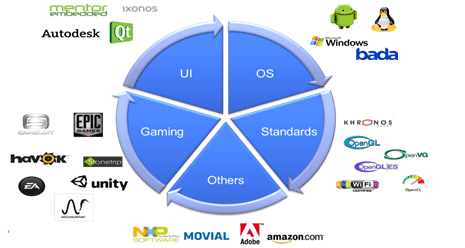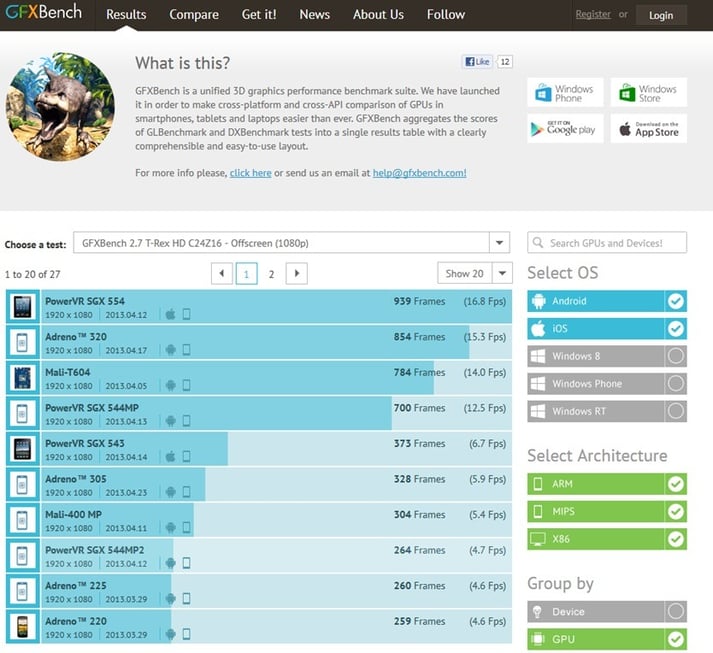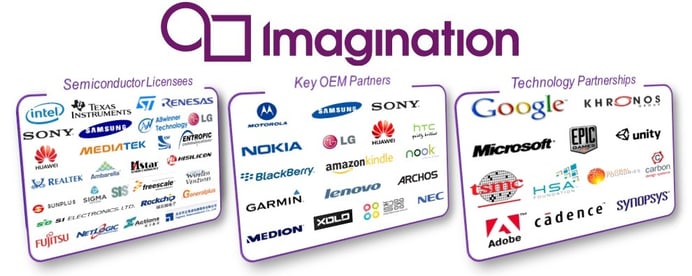- 15 July 2013
- Kristof Beets
Now that we’ve discussed topics such as essential market requirement support, stunning hardware features and optimal driver software, the last (but definitely not least) cornerstone of any successful graphics core is application support. No matter how efficient the hardware is, if there aren’t applications to take advantage of it, it loses its meaning and relevance.
The growing, dynamic PowerVR Insider ecosystem
Any software developer will recognise (maybe forced by their financial teams) that step one of any project is ensuring that there is sufficient market opportunity. Targeting a GPU design with a market size of only 100,000 units is not viable, as the price of your application would have to be high, and even then you’d have to manage to sell a copy to every user out there.
Luckily, market size is where licensing GPU IP can help, as there is not just one SoC vendor using PowerVR technology; there are currently tens of PowerVR customers, and hence all the marketing efforts and volumes add up to create one unified and compatible market opportunity to target. For PowerVR devices, the opportunity for OpenGL ES 1.1 and OpenGL ES2.0 devices has crossed the 1 billion device threshold – the single biggest opportunity for software developers out there – many times larger than any console market segment.
Another angle for software developers to consider is marketing, and both the highest performance devices as well as most popular devices play a key role in this, as demonstrating the best game or application experience on these devices will result in the highest consumer traction. By design, PowerVR has continued to dominate the highest performance product tables over the years.
Results in GFXBench 2.7 (formerly known as GlBenchmark) as of April 2013, grouped by GPU
PowerVR GPUs have enabled some of the world’s most iconic devices, from the Sony PlayStation Vita to the Amazon Kindle Fire to numerous Google Experience Devices, to the latest Samsung Galaxy S4, and of course there are even more to come. All of these great devices offer revenue opportunities and form the solid base of the PowerVR Insider ecosystem.
Great devices, however, are not sufficient in ensuring great games and applications. Efficient and fast-performing hardware helps, but equally important is software development support. Imagination delivers on this from four angles:
– Free interactive developer training and support
– Free software development tools
– Free PowerVR Graphics SDK with reference code including tutorials
– Free, in-depth documentation
All of these essential building blocks to help developers create and optimise for the best possible results on PowerVR hardware are provided for free on developer.imaginationtech.com.
Our Developer Technology team has over 20 years of support experience expanding on the foundations we built during our PC days (e.g. Kyro cards) as well as the Dreamcast console days. Today this is the industry’s most focussed support team dedicated to embedded graphics.
I won’t go into too much detail on our worldwide training sessions, the forum and email based support, content creation tools, shader prototyping environment, performance tuning application, API tracing tool, extensive documentation and articles or SDK tutorial package, because that would double the size of this article! Please visit our developer site to learn more. If anything is missing and we just haven’t been told yet, email our team at devtech@imgtec.com and be part of the solution.
Of course the same mantra of efficiency plays a role in everything which our Developer Technology does, as efficient hardware if driven inefficiently still results in poor user experiences. So the focus of this team is on ensuring that software developers understand and support the same passion for efficiency that Imagination has.
Conclusion
As a student in the 90s, when I started to discuss 3D technology on the Dimension3D forums (https://web.archive.org/web/19970710170643/https://www.dimension3d.com/formain.html), I coined the sentence ‘Nothing is free in 3D’, which not only rhymes but is also one of the ground rules to keep in mind when discussing GPU technology.
After all, you cannot magically deliver more performance. Performance will either cost you silicon area or involve driver effort and/or an architecture redesign and more often than not it will also cost you in terms of increased power consumption. This reality is why I have always appreciated smart GPU solutions that focus on flexibility and efficiency over limited niche feature set brute force designs.
Hopefully this series of articles has given you an insight into the mindset of Imagination and its PowerVR team: it’s all about smart, efficient and flexible GPUs.
These posts have highlighted PowerVR Series5XT’s market leading feature set – covering the complete OpenGL ES 2.0 requirements and even offering a near OpenGL ES 3.0 feature set, matching Microsoft DirectX9_3 feature-level requirements and last, but not least, compliant GPU compute capabilities.
All of these impressive achievements are made possible by the smart and efficiency-focussed architecture which I described next, covering the benefits of ‘true’ TBDR, multi-threading and multi-tasking, and the usage of multi-pipelines before considering multi-core scaling. I’ve also explained our MicroKernel firmware-based flexibility, our early recognition of the need for texture compression with PVRTC, and much more.
The series wrapped up by reminding us all that efficiency hardware is nothing without efficiently written applications covering the continuous efforts from our driver teams, as well as the ecosystem support.
If you have any questions or feedback about Imagination’s graphics IP, please use the comments box below. To keep up to date with the latest developments on PowerVR, follow us on Twitter (@ImaginationTech) and subscribe to our blog feed.
‘Understanding PowerVR’ is an on-going, multi-part series of blog posts from Kristof Beets, Imagination’s Senior Business Development Manager for PowerVR. These articles not only focus on the features that make PowerVR GPUs great, but also provide a detailed look at graphics hardware architectures and software ecosystems in mobile markets.









